Good oral care is part of a healthy lifestyle. It’s easy to keep your teeth and gums in good health. A simple routine of daily teeth cleaning, good eating habits and regular dental visits can help prevent tooth decay (cavities) and gum disease.
Healthy Smile Tips for Life
Healthy smiles make great impressions! To keep your mouth in good condition,
- Always brush twice a day,
- Clean between your teeth daily,
- Eat a balanced diet and limit snacks, and
- Visit your dentist regularly for a dental exam and professional teeth cleaning.
What causes tooth decay and gum disease?
Your teeth are covered with a sticky film of bacteria called plaque (sounds like PLAK). After a meal or snack, these bacteria convert the sugar in foods into acids. These acids attack the enamel, the tooth’s hard outer layer. Repeated attacks can cause the enamel to break down and lead to cavities.
If you brush twice a day and floss once a day, you can remove most of the harmful plaque and bacteria. But if plaque stays on the teeth, it will eventually harden into tartar. It is harder to brush and floss when tartar builds up near the gumline.
Plaque that is not removed can also irritate and inflame your gums, making them swell or bleed. This is called gingivitis, the early stage of gum disease. The good news is that gingivitis can be reversed with professional dental cleaning and good oral hygiene at home.
If gum disease is left untreated, it can cause your gums to pull away from the teeth. Pockets or spaces can form between the teeth and gums. These pockets can become infected. In advanced stages of gum disease, bone loss can occur and teeth may become loose, fall out or have to be pulled.
You can prevent both tooth decay and gum disease by always remembering to brush twice a day and floss daily. It is much easier and less expensive to prevent disease and decay than to treat them!
What are some tips for brushing teeth properly?
Brush twice a day with a fluoride toothpaste to help prevent tooth decay. Fluoride (FLOOR-ide) is a mineral that helps make tooth enamel stronger. There is more than one way to brush your teeth, so it’s a good idea to ask your dentist which one to use. Here are a few tips to help you start a good routine:
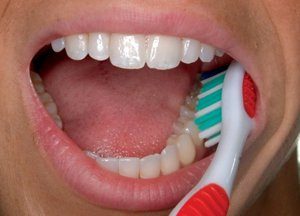
1) Place the toothbrush against your gumline at a 45-degree angle. Move the brush back and forth gently in short (tooth-wide) strokes.
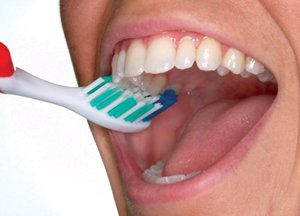
2) Brush the outer tooth surfaces, keeping the toothbrush at a 45-degree angle to the gums.

3) Brush the inner tooth surfaces, still with the toothbrush at a 45-degree angle.

4) Brush the chewing surfaces.

5) Use the top part of the brush to clean the inside surface of the top and bottom front teeth. Use a gentle up-and-down motion.
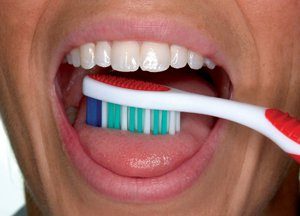
6) Brush your tongue to remove bacteria and freshen your breath.
Why do I need to clean between my teeth?
Even if you brush twice a day, there are places your toothbrush bristles can’t reach. Flossing removes plaque and food particles from between teeth and under the gumline. Your dentist or hygienist can show you the right way to floss. It may feel clumsy at first, but don’t give up. It takes time to get the hang of it. The following suggestions may help:

1) Break off about 18 inches of floss and wind most of it around your middle or index finger. Wind the rest of the floss around a finger of the other hand. This finger will take up the used floss.

2) Hold the floss tightly between your thumbs and forefingers. Guide the floss between your teeth, using a gentle rubbing motion. To avoid hurting your gums, never snap the floss into gum tissue.
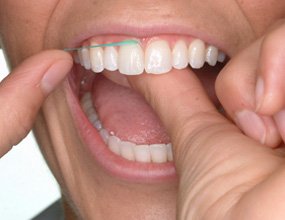
3) When the floss reaches the gum line, curve it into a C shape against one tooth. Gently slide it into the space between the gum and the tooth.

4) Hold the floss tightly against the tooth. Gently rub the side of the tooth, moving the floss away from the gum with up and down motions.
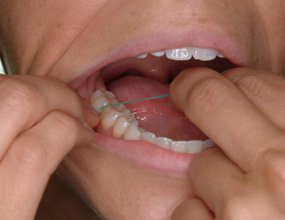
5) Repeat this method on the rest of your teeth. As you move from tooth to tooth, unwind the clean floss with one finger and take up the used floss with the finger on the other hand. Do not forget the back side of the last tooth.
If you haven’t been flossing, you may experience sore or bleeding gums for the first five or so days that you floss. This should stop once the plaque is broken up and the bacteria are removed. If bleeding does not stop, see your dentist.
If you have trouble handling floss, you may wish to try a floss holder or another type of interdental cleaning aid. Interdental cleaners include narrow brushes, picks, or sticks used to remove plaque from between teeth. Your dentist or hygienist can tell you how to use these special cleaners.
There are so many dental products. How do I know what works best?
 Choose products with the American Dental Association Seal of Acceptance. The ADA Seal on a product is your assurance that it has met ADA standards for safety and effectiveness. Look for the ADA Seal on fluoride toothpaste, toothbrushes, floss, interdental cleaners, oral irrigators and mouth rinse.
Choose products with the American Dental Association Seal of Acceptance. The ADA Seal on a product is your assurance that it has met ADA standards for safety and effectiveness. Look for the ADA Seal on fluoride toothpaste, toothbrushes, floss, interdental cleaners, oral irrigators and mouth rinse.- Look for a toothpaste with fluoride. Fluoride helps keep tooth enamel strong and can aid in repairing the early stages of decay. If you have sensitive teeth, your dentist may suggest using special toothpaste.
- Select a toothbrush that feels comfortable in your hand and in your mouth, and use it twice a day. All ADA-accepted toothbrushes – manual or powered – earned the ADA Seal because they can remove plaque above the gumline and reduce gingivitis. For children, choose a child-sized toothbrush.
- Replace your toothbrush every three or four months, or sooner if the bristles become frayed. A worn toothbrush won’t clean your teeth properly. Children’s toothbrushes often need replacing more frequently because they can wear out sooner. If you have hand, arm, or shoulder problems that limit movement, you may find a powered toothbrush easier to use.
- Oral irrigating devices use a stream of water to remove food particles around the teeth. They can be helpful for people who wear braces or dentures. However, an oral irrigator is meant to enhance, not replace, regular brushing and flossing.
- Check mouthwash labels closely. Some mouthrinses just cover up odors; others actually kill germs and reduce plaque. Some mouthrinses have fluoride. If you are constantly using a breath freshener for bad breath, see your dentist. In some cases, bad breath may be a sign of poor health.
- Ask your dentist or hygienist for product tips. People’s needs may differ, and your dental team can point you to products for your specific needs.
we take care
of our patients
Friendly & Comfortable
Our courteous and caring staff will ensure all your dental needs are taken care of.
Advanced Technology
We offer modern dental technology and equipment to provide advanced comfort.
Personalized Care
We take pride in offering our patients a personalized dental experience.
We’re here to help! If you have any questions, please contact us and we’ll be in touch shortly!

